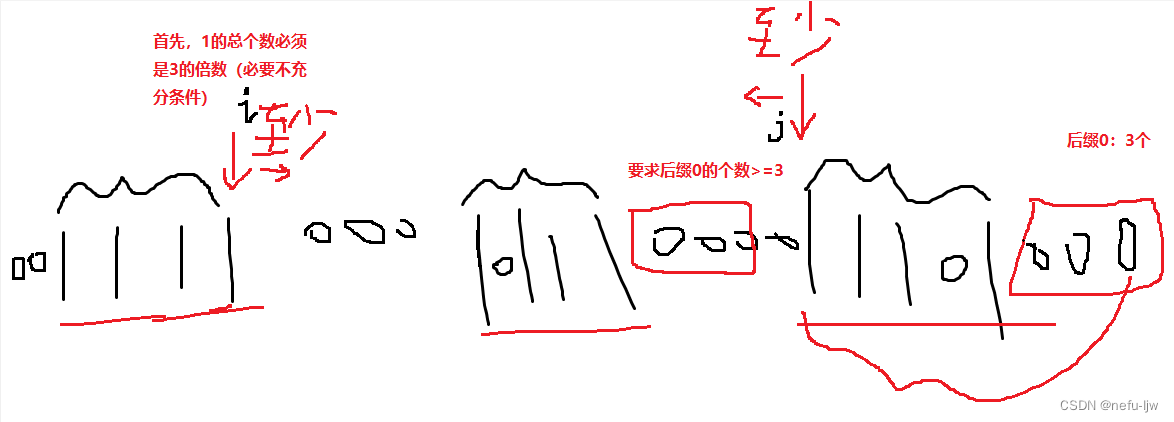题目链接
https://leetcode.cn/problems/three-equal-parts/
思路
为了方便表述,本文将数组或子数组称之为“字符串”或“子串”。
本题的关键在于发现:
- 字符串能被三等分 => 1的总个数必须是3的倍数。必须满足这个必要条件。
- 第3个子串的结束位置被固定在串的末尾,那么第3个子串的后缀0的个数
suffix_zero_count,能用于限制前面第1、2个子串的后缀0个数。因为第3个子串的后缀0是固定的,而前面的两个子串的后缀0是可以往后调整的,只要它们的后缀0个数>=suffix_zero_count,多余的后缀0就可以划分给下一个子串作为前导0。通过这种调整,确定了第1、2个子串的结束位置,同时也确定了第2、3个子串的开始位置(第1个子串的开始位置被固定在串的开头)。 - 最后直接得到三个子串的起始和终点位置,依次比对是否相等即可。
放一个图便于理解:

代码
先切分得到string,再用其初始化bitset,bitset能直接判断是否相等(包括前导0也没有问题)。
class Solution {
public:
vector<int> threeEqualParts(vector<int>& arr) {
int sz=arr.size();
vector<int> ans;
string str;
int count=0; // 1的总个数
for(auto &x:arr){
if(x==1){
count++;
}
str+=(x+'0'); // arr to string
}
// 全是0,没有1,可以任意划分,只要不超过边界即可
if(count==0){
return {0,sz-1};
}
// 1的个数不是3的倍数,划分失败
if(count%3!=0){
return {-1,-1};
}
int ave_count=count/3; // 每个子串含有的1的个数
int end_pos1=-1,start_pos2=-1,end_pos2=-1,start_pos3=-1,end_pos3=-1;
int now_count=0;
for(int i=0;i<sz;i++){
if(arr[i]==1){
now_count++;
if(now_count==ave_count){
end_pos1=i; // 第1个子串中最后一个1的位置
}
if(now_count==ave_count+1){
start_pos2=i; // 第2个子串中第一个1的位置
}
if(now_count==ave_count*2){
end_pos2=i; // 第2个子串中最后一个1的位置
}
if(now_count==ave_count*2+1){
start_pos3=i; // 第3个子串中第一个1的位置
}
if(now_count==(ave_count*3)){
end_pos3=i; // 第3个子串中最后一个1的位置
}
}
}
// 第3个子串后缀0的区间[end_pos3+1, sz)
int suffix_zero_count=sz-end_pos3-1; // 第3个子串的后缀0个数
if(start_pos3-end_pos2-1<suffix_zero_count || start_pos2-end_pos1-1<suffix_zero_count){
// 第2个子串后缀0的区间[end_pos2+1,start_pos3)
// 第1个子串后缀0的区间[end_pos1+1,start_pos2)
// 若第1个子串或第2个子串的后缀0个数不够第3个子串的后缀0个数,则划分失败
return {-1,-1};
}
// 切分得到s1
int suffix_end_pos1=end_pos1+suffix_zero_count; // s1加上后缀0,调整s1的结束位置
assert(suffix_end_pos1<start_pos2);
string s1=str.substr(0,suffix_end_pos1+1); // [0,suffix_end_pos1]
// 切分得到s2
int suffix_end_pos2=end_pos2+suffix_zero_count; // s2加上后缀0,调整s2的结束位置
assert(suffix_end_pos2<start_pos3);
string s2=str.substr(start_pos2,suffix_end_pos2-start_pos2+1); // [start_pos2,suffix_end_pos2]
// 切分得到s3
string s3=str.substr(start_pos3); // [start_pos3,sz)
bitset<30000> t1(s1);
bitset<30000> t2(s2);
bitset<30000> t3(s3);
if(t1==t2&&t2==t3){ // bitset直接判断是否相等
return {suffix_end_pos1,suffix_end_pos2+1};
}else{
return {-1,-1};
}
}
};
/*
[1,0,1,0,1]
ans: [0,3]
[1,1,1,0,0,1,1,0,1,0,1,1,1,1,1,1]
ans: [-1,-1]
*/